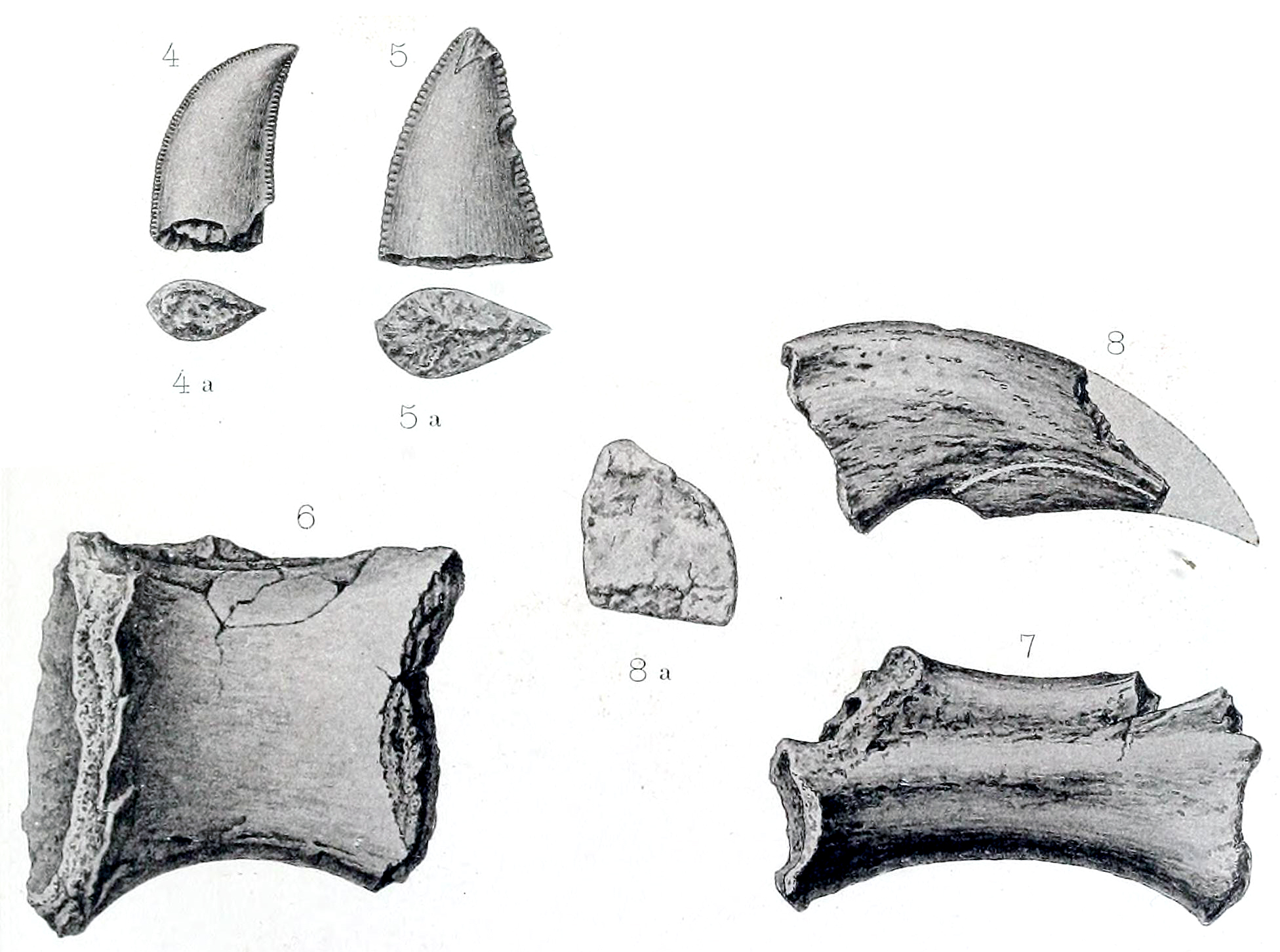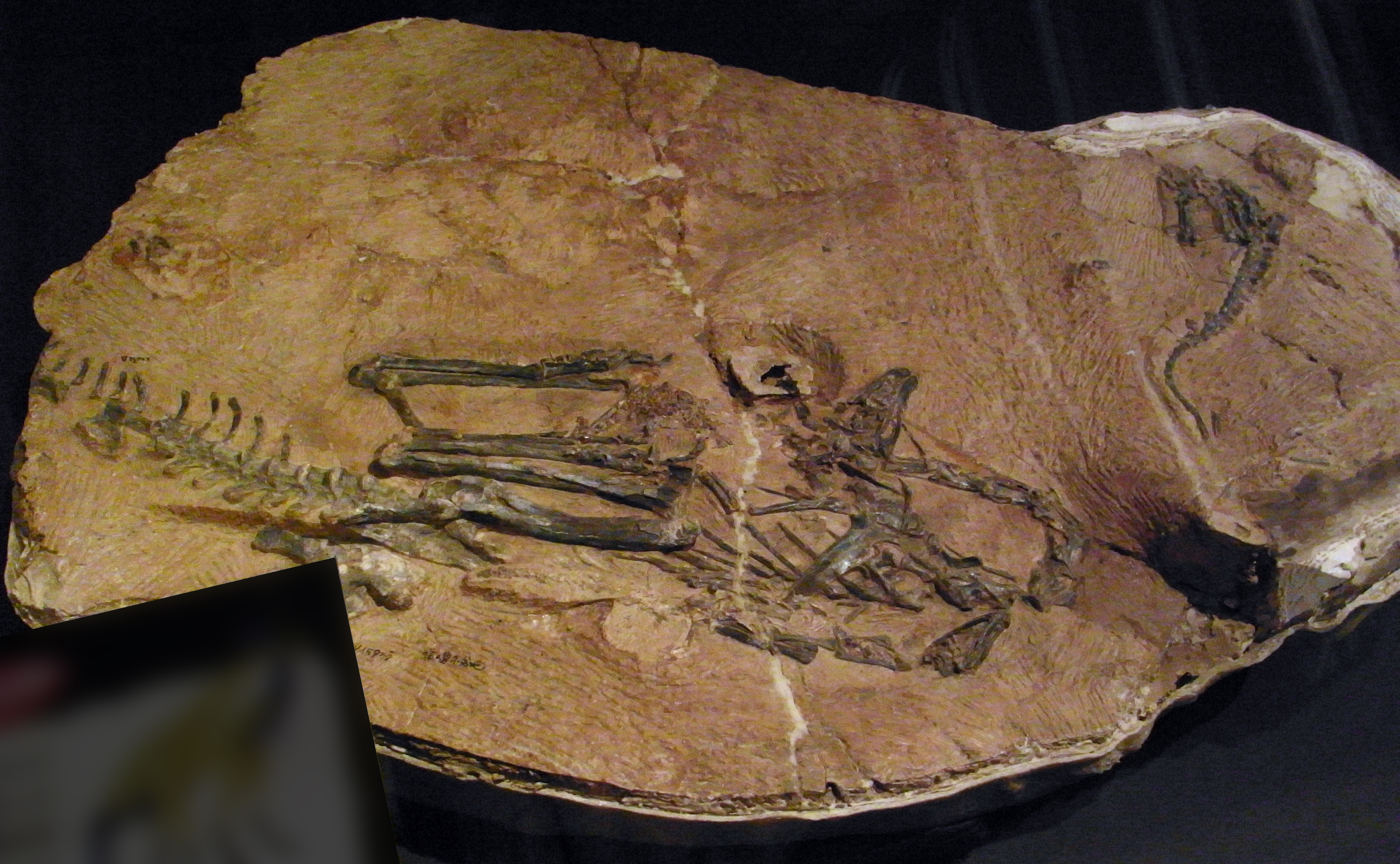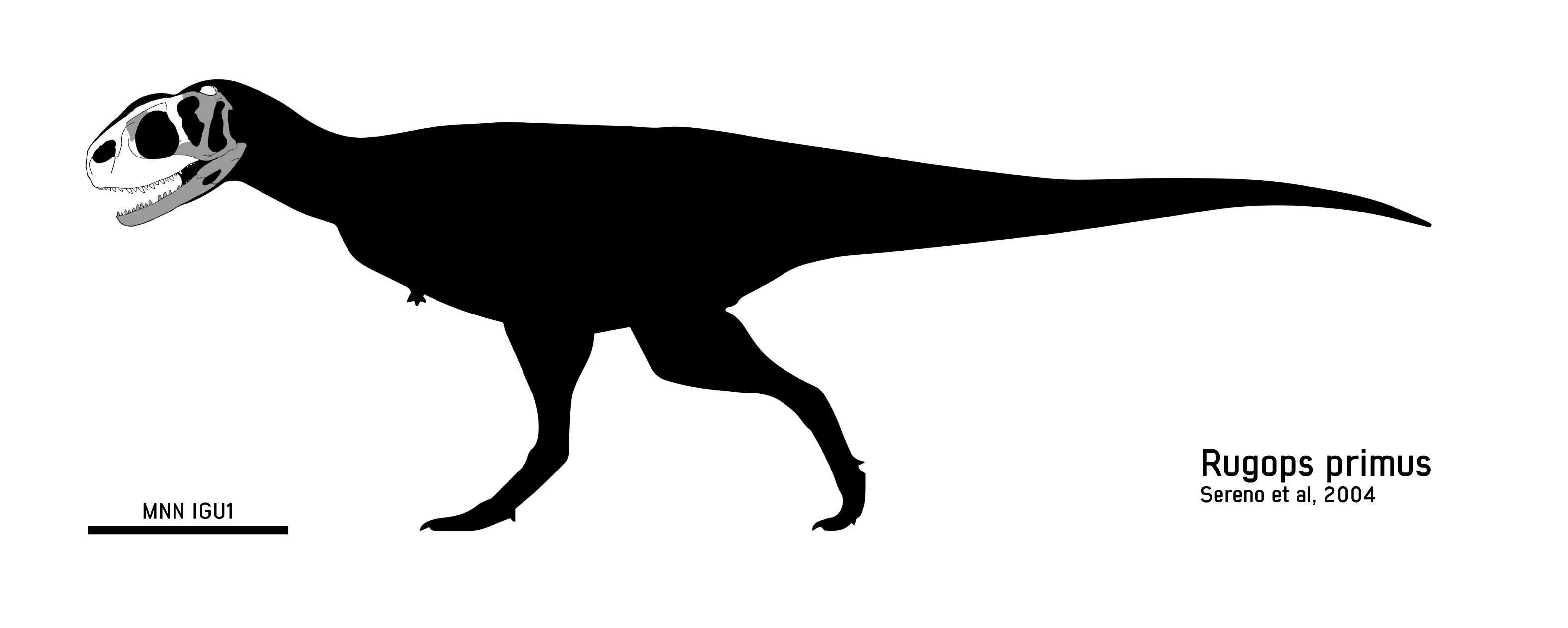|
Abelisaurid
Abelisauridae (meaning "Abel's lizards") is a family (or clade) of ceratosaurian theropod dinosaurs. Abelisaurids thrived during the Cretaceous period, on the ancient southern supercontinent of Gondwana, and today their fossil remains are found on the modern continents of Africa and South America, as well as on the Indian subcontinent and the island of Madagascar. Isolated teeth were found in the Late Jurassic of Portugal, and the Late Cretaceous genera '' Tarascosaurus'', '' Arcovenator'' and '' Caletodraco'' have been described in France. Abelisaurids possibly first appeared during the Jurassic period based on fossil records, and some genera survived until the end of the Mesozoic era, around . Like most theropods, abelisaurids were carnivorous bipeds. They were characterized by stocky hind limbs and extensive ornamentation of the skull bones, with grooves and pits. In many abelisaurids, such as ''Carnotaurus'', the forelimbs are vestigial, the skull is shorter, and bony crest ... [...More Info...] [...Related Items...] OR: [Wikipedia] [Google] [Baidu] |
Majungasaurus Crenatissimus
''Majungasaurus'' (; ) is a genus of abelisaurid theropod dinosaur that lived in Madagascar from 70 to 66 million years ago, at the end of the Cretaceous Period (geology), Period, making it one of the last-known non-avian dinosaurs that went extinct during the Cretaceous–Paleogene extinction event. The genus contains a single species, ''Majungasaurus crenatissimus''. This dinosaur is also called ''Majungatholus'', a name which is considered a junior synonym of ''Majungasaurus''. Like other abelisaurids, ''Majungasaurus'' was a bipedal predator with a short snout. Although the forelimbs are not completely known, they were very short, while the hind limbs were longer and very stocky. Measuring around long and weighing more than , it can be distinguished from other abelisaurids by its wider skull, the very rough texture and thickened bone on the top of its snout, and the single rounded horn on the roof of its skull, which was originally mistaken for the dome of a pachycephalosa ... [...More Info...] [...Related Items...] OR: [Wikipedia] [Google] [Baidu] |
Ceratosauria
Ceratosaurs are members of the clade Ceratosauria, a group of dinosaurs defined as all theropods sharing a more recent common ancestor with '' Ceratosaurus'' than with birds. The oldest known ceratosaur, '' Saltriovenator'', dates to the earliest part of the Jurassic, around 199 million years ago. Ceratosauria includes three major clades: Ceratosauridae, Noasauridae, and Abelisauridae, found primarily (though not exclusively) in the Southern Hemisphere. Originally, Ceratosauria included the above dinosaurs plus the Late Triassic to Early Jurassic Coelophysoidea and Dilophosauridae, implying a much earlier divergence of ceratosaurs from other theropods. However, most recent studies have shown that coelophysoids and dilophosaurids do not form a natural group with other ceratosaurs, and are excluded from this group. Ceratosauria derives its names from the type species, '' Ceratosaurus nasicornis'', described by O.C. Marsh in 1884. A moderately large predator from the Late Jura ... [...More Info...] [...Related Items...] OR: [Wikipedia] [Google] [Baidu] |
Kryptops
''Kryptops'' (meaning "covered face") is an extinct genus of abelisaurid theropod dinosaurs from the Early Cretaceous of Niger. It is known from a partial maxilla (upper jaw bone) found at the Gadoufaoua locality in the western Ténéré Desert, in rocks of the Aptian–Albian-age Elrhaz Formation. The fossils were collected in 2000 by a University of Chicago expedition to Niger led by American paleontologist Paul Sereno. They were then described in 2008 by Sereno and Stephen L. Brusatte, Steve Brusatte. The genus contains a monotypic taxon, single species, ''Kryptops palaios''. Sereno and Brusatte referred several Postcranium, postcranial remains to ''Kryptops'', but later studies have shown that these elements belong to an allosauroid theropod, leaving ''Kryptops'' to be only known from the incomplete maxilla. ''Kryptops'' is one of the oldest known members of the Abelisauridae, making it vital to understanding this family's evolution. Its length is estimated to be around , mak ... [...More Info...] [...Related Items...] OR: [Wikipedia] [Google] [Baidu] |
Tralkasaurus
''Tralkasaurus'' (meaning "thunder lizard") is a genus of abelisaurid dinosaur from the Huincul Formation from Río Negro Province in Argentina. The type and only species is ''Tralkasaurus cuyi'', named in 2020 by Mauricio Cerroni and colleagues based on an incomplete skeleton. A medium-sized abelisaurid, ''Tralkasaurus'' exhibits a conflicting blend of characteristics found among the early-diverging abelisauroids with others that characterize the highly specialized clade Brachyrostra, and thus its position within the clade is poorly-resolved. Discovery and naming The Violante Farm fossil site in Río Negro Province, Argentina, near the village of El Cuy, was discovered in 1999 by Sebastián Apesteguía on the north shore of the Ezequiel Ramos Mexía Reservoir. In a 2018 conference abstract, Matías Motta and colleagues reported new fossil discoveries, including a diverse fauna of dinosaurs, made at the Violante Farm site. The strata exposed are yellowish and greenish sandston ... [...More Info...] [...Related Items...] OR: [Wikipedia] [Google] [Baidu] |
Rugops
''Rugops'' (meaning 'wrinkle face') is a monospecific genus of basal abelisaurid theropod dinosaur from Niger that lived during the Late Cretaceous period (Cenomanian stage, ~95 Ma) in what is now the Echkar Formation. The type and only species, ''Rugops primus'', is known only from a partial skull. It was named and described in 2004 in paleontology, 2004 by Paul Sereno, Jeffrey A. Wilson, Jeffery Wilson and Jack Conrad. ''Rugops'' has an estimated length of and weight of . The top of its skull bears several pits which correlates with overlaying scale and the front of the snout would have had an armour-like dermis. Discovery and naming A skull pertaining to an abelisaurid was recovered during an expedition in 2000 led by Paul Sereno near In-Abangharit, Niger Republic. The specimen came from the Echkar Formation of the Tegama Group which dates to the Cenomanian stage of the Late Cretaceous period, 96 Ma. The formation has also yielded specimens pertaining to the carcharodontosau ... [...More Info...] [...Related Items...] OR: [Wikipedia] [Google] [Baidu] |
Majungasaurinae
Majungasaurinae (after ''Majungasaurus'', itself named after the city of Mahajanga in Madagascar) is a subfamily of large carnivorous theropods from the Upper Cretaceous, found in Madagascar, India, Spain, and France. It is a subgroup within the theropod family Abelisauridae, a Gondwanan clade known for their thick and often horned skulls and vestigial arms. The two subfamilies of Abelisauridae are Carnotaurinae, best known from the South American ''Carnotaurus'', and Majungasaurinae, consisting of Madagascar’s ''Majungasaurus'' and its closest relatives. Their ancestors emerged in the Middle Jurassic, and the clade lasted until the Upper Cretaceous. The majungasaurines were mid-sized, bipedal predators, but relatively slow moving. Their stout legs were built for striding, not running. They had tall, deep heads with powerful jaws, but small forearms without carpals in the wrists. Because of their slow gait and small arms, they likely preyed upon the larger, slower sauropods ra ... [...More Info...] [...Related Items...] OR: [Wikipedia] [Google] [Baidu] |
Eoabelisaurus
''Eoabelisaurus'' () is a genus of abelisauroid theropod dinosaur from the Lower Jurassic Cañadón Asfalto Formation of the Cañadón Asfalto Basin in Argentina, South America. The generic name combines a Greek ἠώς, (''eos''), "dawn", with the name ''Abelisaurus'', in reference to the fact it represents an early relative of the latter. Only one species is currently recognized, ''E. mefi''; the specific name (zoology), specific name honours the MEF, the Museo Paleontológico "Egidio Feruglio", where discoverer Diego Pol is active. It is characterized by reduced forelimb proportions that show primitive characteristics of the Abelisauridae family. Discovery and naming In 2009, Argentinian paleontologist Diego Pol discovered the skeleton of a theropod near the village of Cerro Cóndor in Chubut Province. The remains were found in the Jugo Loco locality that is placed in a series of fine beds of mudstone, marlstone, and limestone in the Cañadón Asfalto Formation. In 2012, bas ... [...More Info...] [...Related Items...] OR: [Wikipedia] [Google] [Baidu] |
Brachyrostra
Brachyrostra (meaning "short snouts") is a clade within the theropod dinosaur family Abelisauridae. It includes the famous genera ''Carnotaurus'', ''Aucasaurus'', potentially ''Abelisaurus'' as well as their close relatives from the Cretaceous Period of Argentina and Brazil plus ''Caletodraco'' from France. The group was first proposed in an analysis conducted by Juan Canale and colleagues in 2008. They found that all South American abelisaurids described up to that point grouped together as a sub-clade of Abelisauridae, which they named based on the relatively unusual shape of their skulls (in comparison with other theropods). They defined the clade Brachyrostra as "all the abelisaurids more closely related to ''Carnotaurus sastrei'' than to ''Majungasaurus crenatissimus''." Paleobiology Anatomy Brachyrostrans were relatively lightly built compared to other large theropods, ranging in size from 6.1–7.8 m (20–26 ft) and 1400–2000 kg (1.6–2.3 short tons) in weig ... [...More Info...] [...Related Items...] OR: [Wikipedia] [Google] [Baidu] |
Chenanisaurus
''Chenanisaurus'' is a genus of predatory abelisaurid dinosaur, with a single known species ''C. barbaricus''. It comes from the upper Maastrichtian phosphates of the Ouled Abdoun Basin in Morocco, North Africa. The animal is known from a holotype, consisting of a partial jawbone and several isolated teeth found in the same beds. ''Chenanisaurus'' is one of the largest members of the Abelisauridae and one of the last, being a contemporary of the North American ''Tyrannosaurus''. It would have been among the dinosaur species wiped out by the Chicxulub asteroid impact and the Cretaceous-Paleogene mass extinction that followed. Description ''Chenanisaurus'' is quite a large abelisaurid, measuring , based on measurements of the holotype dentary. Its size is comparable to that of large abelisaurids such as ''Carnotaurus'' and '' Pycnonemosaurus''. Nicholas R. Longrich and colleagues, the describers of ''Chenanisaurus'', identified distinctive features distinguishing the animal ... [...More Info...] [...Related Items...] OR: [Wikipedia] [Google] [Baidu] |
Spectrovenator
''Spectrovenator'' ("ghost hunter") is a genus of basal abelisaurid theropod dinosaur that lived during the early Cretaceous period in what is now Brazil. The type and only known species is ''S. ragei'', representing a small abelisaurid about long. Discovery and naming ''Spectrovenator'' is known from a single specimen, MZSP-PV 833, recovered from the Quiricó Formation and stored in the Museu de Zoologia da Universidade de São Paulo, and was discovered in the Embira Branca Range, close to the Coração de Jesus Municipality, located in northern Minas Gerais. The specimen consists of a nearly complete skull, partial series of cervicodorsal vertebrae with ribs, a complete sacrum, partial series of caudal vertebrae, and well-preserved hindlimb and hip bones. The genus name ''Spectrovenator'' is derived from Latin words ''spectrum'' ("ghost") and ''venator'' ("hunter"), which refers to the unexpected discovery of its relatively complete skeleton under the holotype of '' Tapuia ... [...More Info...] [...Related Items...] OR: [Wikipedia] [Google] [Baidu] |
Abelisaurus Comahuensis
''Abelisaurus'' (; "Abel's lizard") is a genus of predatory abelisaurid theropod dinosaur alive during the Late Cretaceous Period (Campanian) of what is now South America. It was a bipedal carnivore that probably reached about in length, although this is uncertain as it is known from only one partial skull. Discovery and naming Coining the type species ''Abelisaurus comahuensis'', both genus and species were named and described by Argentine paleontologists José Bonaparte and Fernando Emilio Novas in 1985. The generic name recognizes Roberto Abel as the discoverer of the type specimen, and also as the former director of the provincial Museum of Cipolletti in Argentina, where the specimen is housed. It also incorporates the Greek ('), meaning 'lizard'. The specific name ''comahuensis'' honors the Comahue region of Argentina, where the fossil was found. The holotype, MC 11098, was in 1983 uncovered at the "Cantera de la Pala Mécanica"-site in the Lago Pellegrini quarries expl ... [...More Info...] [...Related Items...] OR: [Wikipedia] [Google] [Baidu] |
Tarascosaurus
''Tarascosaurus'' ("Tarasque lizard") is a genus of abelisaurid theropod dinosaur from Late Cretaceous of France. It was a relatively small theropod measuring long. Discovery After having in 1988 identified an upper jaw bone found near Pourcieux as belonging to a member of the Abelisauridae, French paleontologist Éric Buffetaut reviewed the known remains of larger theropods found in the Late Cretaceous of Europe concluding they all were of abelisaurid affinity. Most of these fossils, earlier named as ''Megalosaurus pannoniensis'', ''Megalosaurus hungaricus'' and ''Megalosaurus lonzeensis'', he considered to be ''nomina dubia'' because of the paucity of the material. However, when in the collection of the University of Lyon he discovered some theropod bones once excavated by an unknown collector at an escarpment of a place named ''Lambeau du Beausset'', in the "syncline of Le Beausset" (in French: ''synclinal du Beausset''), Buffetaut and Jean Le Loeuff named and described th ... [...More Info...] [...Related Items...] OR: [Wikipedia] [Google] [Baidu] |










